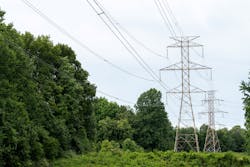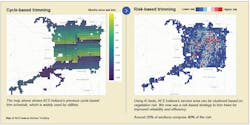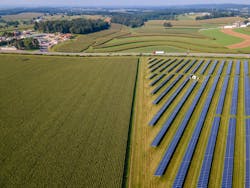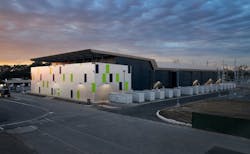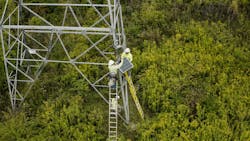The transition to a decarbonized, clean energy future requires the electric utility industry to manage two exacting challenges successfully in the years ahead: Utilities around the world will need to accelerate the deployment of grid-connected renewable energy resources substantially while delivering reliable and affordable energy. Achieving both these outcomes will be far from easy.
According to energy policy simulator modeling by Energy Innovation Policy & Technology LLC in 2021, the world will need nearly quadruple the amount of renewable energy currently connected to the grid by 2030 to achieve the ambitious goals set by the Paris Agreement and limit global warming to 1.5°C (2.7°F). In the U.S., this calls for investing in new clean energy solutions and technologies that will reduce dependence on fossil fuels, grow renewable capacity, and improve grid performance to reliably power homes, businesses and transportation for years to come.
Artificial intelligence and machine learning (AI/ML) will be critical to this process. These technologies can enable utilities — like The AES Corporation — to supercharge their data usage to identify grid patterns, inefficiencies and other valuable insights, helping grid owners and operators to support an efficient and repsonsible clean energy transition for grid customers while optimizing their businesses.
AES is pioneering new technologies and programs with AI/ML to create data-driven methods that advance its green transition while maintaining grid reliability and providing new value to customers. The utility’s deep commitment to innovation drives these advancements forward every day as it embraces a dynamic, forward-thinking approach — investing in technology that is scalable now, in the near future and years from now — to accelerate the future of energy.
AI For VM
Today, vegetation is a leading cause of unplanned electric service outages, according to the Federal Energy Regulatory Commission (FERC). In 2021, Accenture analysts estimated U.S. utilities spend up to $8 billion on vegetation management each year. Effectively managing the growth of trees, shrubs, and vegetation near power lines and other vital parts of the grid is crucial to maintaining grid reliability and safety, minimizing power outages and reducing costs. And, as climate change progressively leads to more severe weather events, outage risk will increase unless grid operators proactively and intelligently manage vegetation in their service territories.
AI/ML advancements enable grid operators to identify areas most in need of tree trimming instead of using the traditional cycle-based approach to vegetation management. By analyzing historical trimming data, tree-related outage data, utility-owned and publicly sourced imagery, weather patterns and financial information, utilities can prioritize specific locations for trimming with the greatest expected impact on grid reliability.
These AI/ML innovations are already at work every day at AES. The utility uses data insights to deploy resources to areas at higher risk for an outage, deprioritizing areas that do not have an immediate need. The results have been improved reliability and lower maintenance costs. AES Indiana, in particular, has reduced vegetation-related interruptions by 3.5% in less than two years, a meaningful improvement for customers. AES continues to build on this progress by improving its vegetation analytics model with satellite imagery.
What is more, the utility has found that when it is more targeted and strategic with its resources — money, people and time — it can smartly and efficiently meet customer needs while accelerating grid modernization.
AI Asset Optimization
Connecting renewables to the grid more quickly while providing affordable, reliable energy to customers requires finding new ways to optimize existing assets, so clean energy can be provided when and where it is needed. AI/ML technologies can make this possible by identifying irregularities and trends in asset performance that indicate potential system failures, helping to prevent service disruptions, protect equipment, shorten downtime and even extend the lifetime of assets.
AES uses AI/ML advancements to analyze massive amounts of data and predict when assets may fail, enabling the utility to perform preventive maintenance rather than being reactive and waiting for an issue to occur. This practice keeps the utility’s systems up and running, so it can provide reliable energy to customers. AI/ML advancements also make it possible for utilities to optimize energy production and asset operation based on market and system conditions, making energy costs more affordable.
Furthermore, AI/ML tools can help utilities to be better prepared for weather-related challenges by understanding the amount of energy that will be needed in various conditions and the corresponding amount that can be generated and delivered. Weather heavily influences both electricity demand and supply. For example, when it is hot, air conditioning use and demand for energy surges, but so can the production of solar-generated electricity. Weather conditions like severe storms — which are becoming more common — can directly affect the output of wind and solar facilities and a utility’s ability to deliver energy where and when it is needed most.
With AI/ML, grid operators can anticipate weather patterns, so they can more efficiently dispatch energy to load centers while supporting grid reliability and emergency response. Asset owners also can use AI/ML to co-optimize storage and plant output to improve production and operations. AES uses advanced data analytics and ML to translate weather forecasts into generation forecasts. These more precise predictions make it possible to operate physical assets more efficiently. Initial field-testing of its next-generation wind forecasting model at its Valcour Wind sites in New York showed an initial 15% gain in wind forecasting accuracy over current industry tools.
An Eye on the Line
AES also is deploying dynamic line rating — a technology that enables high-fidelity calculations of how much energy can be moved through a power line at a specific time based on ambient and line conditions. Air temperature, solar radiation, and wind speed and direction all affect power line performance and capacity. For example, wind traveling across a power line can increase the amount of energy that can be carried through the line.
Historically, grid operators did not have access to the data nor the computational power to consider detailed situational information when determining how much energy can be moved through the grid. Instead, operators have relied on conservatively set static line ratings based on worst-case scenarios and best estimates. This made sense in the 20th century when the standards were first set and tools were limited. Now, as demands on the grid grow, antiquated practices often lead to under-delivery of energy across the grid and further delay the decarbonization of the energy system.
The value of this untapped grid capacity is well recognized, including by FERC, which will soon require grid operators to start applying hourly (or better) calculations to near-term transmission operations, to maximize the transfer capacity of each line. However, even this approach leaves some untapped line capacity.
By adding wind speed and direction to ambient line rating and installing sensors in key locations on the grid, grid owners and operators will have a more accurate and dynamic understanding of the amount of energy that can flow through a line. As weather changes throughout the day, so does production and consumption of energy, and having a granular, accurate view of line carrying capacity will help to make the system more efficient.
The ability to optimally use the electrical grid will be fully realized when asset owners and grid operators use robust operational data — contextualized by AI — to bridge the gap between planning and operations with dynamic, high-fidelity knowledge.
A Digital Grid
To meet the U.S. goal of creating a clean and efficient grid by 2035 while maintaining affordability and reliability, utilities must think beyond incremental deployments of market-ready technologies and think instead about modernizing the grid at scale and speed. According to the National Renewable Energy Laboratory in its study Examining Supply-Side Options to Achieve 100% Clean Electricity by 2035, this will require a massive build-out of renewables at up to six times the current rate and a tripling of current transmission capacity. To do this, the energy industry must integrate new grid-enhancing technologies (GETs) that maximize capacity along new and existing transmission lines.
GETs — like dynamic line rating — are largely software solutions that produce the data-rich insights needed to reach decarbonization goals. As more digital assets are installed on the grid, owners, operators and utilities will receive more precise and timely information about how their energy system works under a variety of conditions. Especially when coupled with AI-assist tools, this data will enable smarter predictive and real-time decision-making and help the industry build a holistic end-to-end view of the grid.
Such a reality may seem complex, but it is achievable in a digital system with increasingly accurate data, flexible and responsive assets, and advanced computational capabilities. Investing in these improvements is critical because existing models, built for analog fossil fuel systems and one-way power flows, struggle to accurately represent the potential of the wide variety of resources on the grid.
Inaccurate representation of grid assets makes the system less reliable and more expensive to operate, according to Queued Up: Characteristics of Power Plants Seeking Transmission Interconnection as of the End of 2020, a study by Lawrence Berkeley National Laboratory. Berkeley Lab published a series of briefs in 2023 analyzing interconnection cost trends across five U.S. wholesale electricity markets that found incomplete modeling of grid carrying capacity results in grid underutilization and network upgrade costs reflecting 20% to 40% of new-generation-project capital expenditures.
The digitalization of the grid also enables the application of a system of protocols and standards to help ensure grid reliability and control, not unlike how the U.S. provides predictable and coordinated internet service. Beyond reliability benefits, digitalization can help to identify optimal locations for energy storage across the grid, so owners and operators can create electron warehouses — or energy buffers — for on-demand access by customers in a reliable, resilient and affordable way. This buffer is also valuable because it can help to solve the increasing number and complexity of resources in the distribution system as well as responsively and flexibly address the dynamic needs of the transmission system.
Virtual Power Plants
Underlying the transition to a digital grid are AI/ML. The data collected, modeled and analyzed using AI/ML creates a virtuous circle of continuous refinement and improvement.
By allowing trained AI to engage in problem-solving conversations with engineers, the tedious and manual problem of grid modeling for planning and interconnection can be improved significantly. The planning process can be enhanced even further by high-quality data streams from digital resources and advances in computing efficiency, speeding up modeling and optimizing the incorporation of new assets. These advancements in AI-assist, high-quality data and computation help to bring T&D together into a fully integrated, holistic grid-planning process with an interconnected workforce that now has bandwidth and data-driven insights to identify and solve future grid, customer and decarbonization needs in a coordinated way across all levels of the grid.
A workforce so equipped can leverage AI/ML to optimize active participation of distributed energy resources (DERs), including virtual power plants (VPPs), to solve local grid needs in a more delegated and distributed manner. By aggregating a collection of smaller energy resources (for example, smart thermostats, electric vehicles, batteries, distributed solar and other smart devices), VPPs can provide generation resources, reliability and economic value to the grid — much like traditional power plants. When these assets are optimized and coordinated intelligently, they provide cost-effective electrification, a locally resilient energy supply and grid services while reducing T&D bottlenecks.
As a next-generation utility, AES is at the cutting edge of exploring new technologies to build a digital grid that is not only capable of greater flexibility and reliability but optimized to handle and integrate the renewable assets that will be needed to decarbonize the energy system.
Where To Go From Here
By embracing intelligent digitalization, exploring innovative solutions and utilizing data — which compounds in value over time — grid owners, operators and energy producers can build a more dynamic and resilient grid that reliably delivers clean, affordable energy. AES is already leveraging AI to assist in vegetation management, weather forecasting and asset optimization, and it has started using AI to analyze transmission system data to enable dynamic line ratings. Embracing a digital future powered, in part, by AI/ML will enable utilities to reach their clean energy goals more quickly. And, a digital system might be closer than the industry thinks.
An increase in DER capacity is forecasted to align with grid-scale capacity additions through 2027, according to a May 2023 report, Real Reliability: The Value of Virtual Power, from The Brattle Group. Digital energy devices are a growing part of households and businesses. GETs are being strategically adopted by major utilities. AES Indiana and Ohio’s 2023 deployment of the first large-scale dynamic line rating system in the U.S. is a great example. The energy system will continue to see more inverter-based generation that is inherently digital, flexible, and capable of being turned off and on to address demand peaks and troughs, as well as dynamic system conditions.
AES is committed to advancing a responsible transition and driving innovation in the renewables sector, utility operations and energy markets — but this must be a collective effort. It is critical for all players in the energy ecosystem to adopt an innovative mindset and invest in advanced digital technologies to build a more resilient and sustainable energy future.
The industry must move quickly to bring more renewables online while improving grid reliability and energy affordability, and AI/ML will help to achieve these goals. Fortunately, the work the industry is doing today will pay additional dividends in the future. The more data that is collected, the better insights the industry can glean and apply proactive steps to build a stronger, more dynamic and inclusive grid that runs increasingly on renewable energy resources.
Alexina Jackson is vice president of strategic development at The AES Corporation. In this role, Jackson is responsible for developing AES’ vision for the electric grid of the future and an ecosystem to drive toward this shared vision. Previously at AES, Jackson worked in a customer innovation leadership role. Before joining the company, she worked as an attorney with Crowell & Moring LLP and as a strategy consultant in the United States, Brazil, Spain and France.
About the Author
Alexina Jackson
Alexina Jackson is vice president of strategic development at The AES Corp. In this role, Jackson is responsible for developing AES’ vision for the electric grid of the future and an ecosystem to drive toward this shared vision. Previously with AES, Jackson worked primarily in customer innovation leadership roles. Before joining AES, Alexina worked as an attorney with Crowell & Moring LLP and as a strategy consultant in the United States, Brazil, Spain and France.

